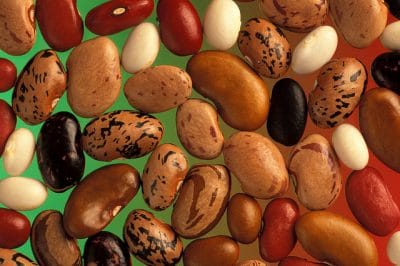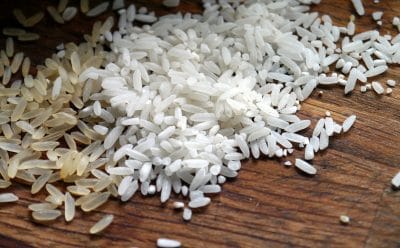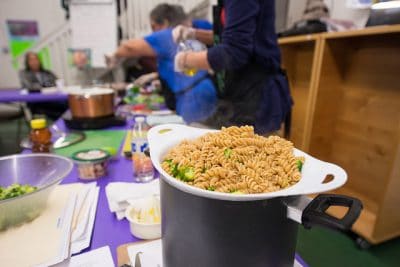This site contains affiliate links. As an Amazon Associate, I earn a commission from qualifying purchases at no extra cost to you. Full Disclosure Here.
Putting aside a good long term supply of food can be economically daunting. Not everyone has the ability to drop thousands of dollars in one shot and get an instant supply. In other cases, logistics, dietary needs, or even where you live will dictate how you put together your food supply. But the biggest hindrance in assembling a prepper food cache usually boils down to money.
However, because we are blessed to live in a wealthy, capitalist nation that is also a food exporting nation, we have access to some incredibly cheap and healthy food. Selecting what food the frugal prepper should be buying for storage is something of a tossup. Your idea of frugal and my idea of frugal may be wildly different. Each person’s lived experiences dictate where they draw a financial line, and what they consider acceptable frugal food to store. After all, there is no reason to invest in cheap garbage food or food you won’t enjoy eating.
With that in mind, I’ve worked up a list of five off the shelf foods that save you money, while filling your pantry. Now I don’t want to knock any of the fine freeze-dried food companies out there – my own pantry has an assortment of different freeze-dried goods, but sometimes you literally just can’t afford a $20 can of food. Let’s look at some ways you can stretch that dollar, and expand your pantry.
Dry Beans
Even in retail quantities, beans are incredibly cheap. If you can buy them in bulk quantities, they get even cheaper. As a general rule, you can expect to buy a pound of dry beans at retail for about what you’d pay for a can of prepared beans. And you get a lot more servings out of that pound of dry beans.
Beans are incredibly nutritious and offer an excellent source of protein. However, beans are an incomplete protein, meaning that they do not have at least one essential amino acids. It is very easy to make beans a complete protein by simply pairing them with whole grains like rice, and we all know how tasty beans and rice are!
Storing dried beans, like any other dry staple might present challenges for the prepper or homesteader. There are a lot of different ways of doing it, like five-gallon buckets with desiccant packs, storing in airtight, sealed jars, or other similar methods. In fact, stored properly, beans are considered to have an indefinite shelf life!
A big part on how you choose to store your beans depends on the logistics of your home or survival retreat. If you don’t have room for big buckets, you’ll have to partition your supply out in other ways. For short term storage of about a year or so, you could even leave your beans in their retail package, tucked way in a cool and dry place.
For just pennies a serving, and assuming you will have the means to properly cook them in an emergency, beans are a wonderful survival food and great everyday food for that matter. Inexpensive, tasty, and healthy, what more do you want from your emergency supplies? I’d consider storing a few complimentary spices to go with them, but that is something any prepper should be doing with their food supplies.
Dry Rice
Right on the heels of dry beans, is the companion grain rice. Now we should all know that rice is both affordable and highly nutritious. It can be had in bulk quantities by shopping at restaurant supply stores and is a great way to stretch out many different sorts of meals.
While there are all sorts of different types of rice – they mostly vary either in flavor or cooking properties, and nutrition. Brown rice is going to have more nutritional value than white rice, but a very short shelf life of about six to twelve months. White rice has a longer shelf life – about five years but lacks the nutrition of brown rice.
Choosing what kind of rice you are going to include in your prepper stores is important. If you eat a lot of it, brown rice can simply be rotated through, and you’ll have to accept a relatively short shelf life for this important staple. If you favor white rice, you’ve got a lot more choice in storage options, but you should still rotate at least some of it so that you aren’t stuck with a rapidly aging out supply of white rice.
In both cases, rice can serve as the foundation for a meal, (add your favorite meat, seafood, veggies, beans and/or spices or sauces to make a nice, filling meal) or used to stretch out soups and stews. The addition of rice to soup and stews adds valuable carbohydrates and serves as an inexpensive filler. Added to beans, it forms a complete protein that turns a cheap meal into a nourishing and long term sustaining meal.
Store rice the same way you would beans or other dry foods, in an airtight or vacuum sealed container and in a cool, dry place. This ensures maximum shelf life and keeps bugs and dirt out of your food. Label the date you purchased the rice, and rotate it out before the end of its shelf life. Discard any rancid or strange smelling rice. Properly kept and rotated, you’ll find rice of any sort is an affordable way for the frugal prepper to stretch and bulk out their supplies without sacrificing health or taste.
Pasta
Another inexpensive shelf-stable food that has long term storage properties, pasta is ideal for the frugal prepper who wants an easy to prepare, tasty and familiar survival food. Properly stored, dry pasta can last up to two years past the expiration date on the product.
Again, you’ll want to store your dry pasta in airtight or vacuum sealed containers and put it in a cool and dry place. Are you seeing a common theme here? Dry goods should be kept dry, away from air, sunlight and warm temperature. The colder you can keep them, the longer they will last.
Pasta containing eggs, or made with whole grains will have a shorter shelf life than pasta made without those ingredients. How much pasta you store depends entirely on how much of the stuff you eat. And again, you’ll want to rotate through your supplies. So if you eat a pound of pasta a month, put aside twelve pounds of pasta and keep buying your usual monthly supply, constantly eating the oldest pasta in your pantry and replacing it with fresh.
The main benefit of pasta, beyond providing a familiar and tasty carbohydrate base, is the fact that you can readily integrate it with all sorts of other prepper foods. Freeze dried meats and veggies go great with pasta, as do garden-grown vegetables and harvested wild game. There is no limit to what you can do with pasta, and wouldn’t you like to go through an emergency situation with tasty, familiar and healthy food, instead of some tactical mystery food?
SPAM
No, I’m not talking about the email that fills your inbox offering prescription drugs and inheritances from Nigerian princes. I’m talking about the canned pork product that has been feeding people since before WWII and was, in fact, an important military supply during WWII for the US and its allies.
Spam, (or SPAM as the good folks at Hormel would prefer you spell it) isn’t the cheapest meat out there. And it’s pretty heavily laden with salt and fat, but it has fueled people in the bitter Russian winters fighting Nazis and serves as a popular food in the present day. There are cheaper meat alternatives, and at about $2.50 or so a can when you carefully shop, the price does add up, but I think it’s worthwhile.
Already cooked, and capable of being served hot or cold, Spam brings a lot to the prepper table. Slice it and fry it for sandwiches, dice and fry it to mix with beans and rice, serve a slice alongside fresh veggies, or use anywhere else you’d use meat. I personally like the stuff, and if you do, a couple dozen cans in your prepper larder won’t hurt a thing. Plus, they are a great thing to grab when you are in a hurry or to just toss in your bugout bag.
Drink Mix Powders
Ok, this one might seem way off base, but this time it is ok to drink the Kool-Aid. Or Gatorade. Or lemonade, or Tang, or what have you.
After writing about beans, rice, pasta, SPAM, (and you should check out the peanut butter article I did too!) I decided the frugal prepper pantry should have a little fun. I’ve often said, and will continue to say, prepping is miserable if you don’t have foods you like to eat, are familiar with and enjoy. This is even more important if you are prepping with kids. An emergency is the worst possible time to change up anybody’s diet. And it is also nice to have a little fun.
Flavored drink mixes of all sorts offer everything from simple flavor to added vitamins, minerals, and electrolytes. Equally important, they can cover up the flavor of chemically treated or purified water. Sometimes the water is healthy, but gross tasting. A couple spoonfuls of drink powder goes a long way to making it more palatable.
On a hot day, or when you’ve been exerting yourself, having an electrolyte drink mix can be an important part of maintaining your health and personal comfort. Or if you choose to, you might have instant coffee or tea, hot cocoa, or various other drink flavorings. The sky – and grocery store is the limit!
But as with anything, choose your drink mix carefully. What will you actually drink? What has a good shelf life? Are you buying for pleasure or to get electrolytes or just because you drink the stuff every day already? As a general rule, vitamin drink mixes will have a shorter shelf life than drinks that are little more than sugar, color, and flavoring. Either way, you should expect several years of storage in the now familiar cool, dry and airtight conditions.
Mix and match what you like, and remember, when the world is miserable, the power is out, civil unrest is weighing heavily on your heart, that sometimes a nice cup of your favorite drink is all it takes to make the world around you a nicer place for a few minutes.
Conclusion
There are a lot of shelf-stable foods that can be stored for one or more years that would suit the needs of the frugal prepper. These five are some of the most common, most affordable and most versatile food products that be had in the stores.
How you incorporate (or choose not to incorporate) these items into your prepping is entirely up to you. Every person has their own unique tastes and approaches to cooking, and those are shaped by culture, religion, health, personal beliefs, and more. There is no one size fits all approach to prepping or building up your emergency supplies, and you shouldn’t rely on any one type of food supply.
My own preps are a mix of bulk freeze dried foods, off the shelf consumer goods, and the odd bit of dry bulk goods. I have learned that diversifying my supplies allows me to quickly vary how I respond to different kinds of emergencies.
By adding various long life, off the shelf foods to your pantry, you’ll give yourself greater flexibility, choice and save a good bit of money. Sure, the cooking time might be longer in some cases, but it is pretty rare that you won’t have the time to at least boil water for a pot of beans and rice. However you do it, the important thing is that you are prepping and planning for an emergency that will hopefully never come.
Author’s Bio
Steve Coffman is a freelance writer and consulting historian. He has a BA in US history from The Evergreen State College and lives near Tacoma, Washington. He collects antique telephone insulators and is presently researching labor union relations in Washington State during WWI.














15 Responses to “Five Off The Shelf Foods For The Frugal Prepper”
@Ken Chambers; One of the problems I have had with vacuum sealing pasta is pasta can be sharp and will poke through the vacuum bag. I make my freeze-dried meals by mixing, i.e., pasta, freeze-dried meat, dehydrated veggies, and sauce powders and vacuum seal them. The pasta meals leak unless I put thin cardboard between the food and the bag. So I just put pasta and meals in mylar with O2 absorbers get most of the air out and seal, no leaks.
I second @Fizzlecat, we eat Chunky soups over rice often! As for SPAM, while it is not something we eat on a regular basis, we do always keep some on hand, there are a lot of different flavors to choose from these days, I recently came across a knock off brand that’s bacon flavored (I’m planning to use it to make a hash for breakfast one of these days).
I’d add the vienna type sausages to the list as well. Again, not something we eat regularly, but we are familiar enough with it that we include it in our stores.
The same with hashes, Chef Boyardee items, canned tamales, different canned fish, chicken and dumplings, etc. All can be obtained cheaply at the local grocery as well as at the dollar stores.
Are they your healthiest options? Maybe not. But they are inexpensive, satisfying/filling, and have calories (and some nutrition value). And if you are of a ‘certain age’ (as I am), they may be comfort foods!
I have found that storing a few cans of hearty soups, like the Chunky beef and veggie soups, are good go-t0s. They go really nicely on a bed of rice! Tasty, quick and it’s filling! It’s more like a meal instead of just soup. Just season the way you like it! Makes a good “hurry-up” meal, or good for preps! Also the gravy like soups taste good on pasta as well. Plus you’re getting your veggies in!
You can dry can brown rice to keep it from going rancid. This also works for nuts, seeds, whole wheat, etc.
If you store a lot of beans, rice, pasta, go online and get a lot of recipes so you don’t get bored eating the same thing day in and day out. Appetite fatigue is a real thing and can be fatal. Also for planning purposes, legumes (dried beans, peas, lentils) have twice the calories as grains. Rice, beans, and pasta all require water and power to cook. Learn cooking methods that require less water and shorter cooking times.
@Mary About once a month we shred up about a half can of SPAM using an old fashioned vegetable shredder, add a couple of tablespoons of chopped onion, a tablespoon of hot dog relish, some mayo to taste, mix it up real well with a fork and then spread it on bread to make an absolutely delicious sandwich. Goes great with a can of your favorite soup. The unused SPAM gets used to make english muffin, egg, cheese and SPAM sandwiches. A lot of good eating packed in one of those cans.
As I was watching the video on storing pasta I kept thinking about using my vacuum sealer to store the pasta in and then storing them in the buckets, perhaps even with some oxygen scavengers for good measure. The vacuum seal bags are a bit thicker gauge than storage bags which seems like a good think if your trying to keep a bug out. What do you think. Worth it or a waste of money?
Beans are also exelent for sprouting.
I was agreeing with your selection until you got to Spam. It would definitely have to be a survival situation for me to eat. that. There are lots of other canned and freeze dried meat products I would have available before that.
Junket for pudding and smoothies. Cornstarch can also be made into a pudding. Cornstarch also has no expiration date.